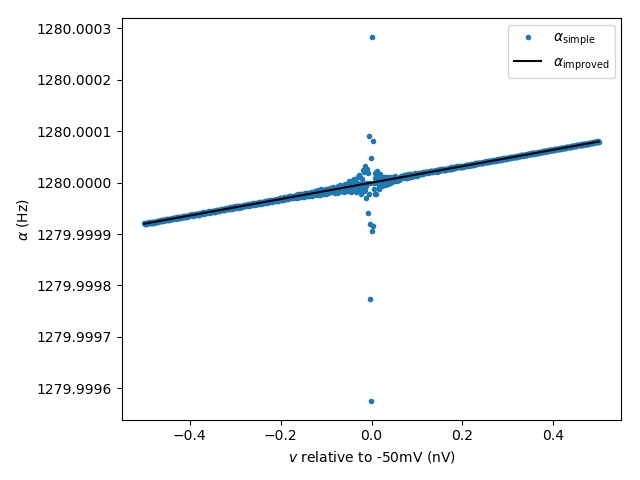Example: exprel_function
Show the improved numerical accuracy when using the exprel() function in rate equations.
Rate equations for channel opening/closing rates often include a term of the form \(\frac{x}{\exp(x) - 1}\). This term is problematic for two reasons:
It is not defined for \(x = 0\) (where it should equal to \(1\) for continuity);
For values \(x \approx 0\), there is a loss of accuracy.
For better accuracy, and to avoid issues at \(x = 0\), Brian provides the
function exprel(), which is equivalent to \(\frac{\exp(x) - 1}{x}\), but
with better accuracy and the expected result at \(x = 0\). In this example,
we demonstrate the advantage of expressing a typical rate equation from the HH
model with exprel().
from brian2 import *
# Dummy group to evaluate the rate equation at various points
eqs = '''v : volt
# opening rate from the HH model
alpha_simple = 0.32*(mV**-1)*(-50*mV-v)/
(exp((-50*mV-v)/(4*mV))-1.)/ms : Hz
alpha_improved = 0.32*(mV**-1)*4*mV/exprel((-50*mV-v)/(4*mV))/ms : Hz'''
neuron = NeuronGroup(1000, eqs)
# Use voltage values around the problematic point
neuron.v = np.linspace(-50 - .5e-6, -50 + .5e-6, len(neuron))*mV
fig, ax = plt.subplots()
ax.plot((neuron.v + 50*mV)/nvolt, neuron.alpha_simple,
'.', label=r'$\alpha_\mathrm{simple}$')
ax.plot((neuron.v + 50*mV)/nvolt, neuron.alpha_improved,
'k', label=r'$\alpha_\mathrm{improved}$')
ax.legend()
ax.set(xlabel='$v$ relative to -50mV (nV)', ylabel=r'$\alpha$ (Hz)')
ax.ticklabel_format(useOffset=False)
plt.tight_layout()
plt.show()
